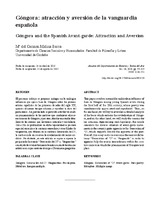Góngora: atracción y aversión de la vanguardia española
Góngora and the Spanish Avant-garde: Attraction and Aversion
Autor
Molina Barea, María del Carmen
Editor
Universidad Autónoma de Madrid. Departamento de Historia y Teoría del ArteFecha
2014Materia
Góngora y Argote, Luis de, 1561-1627Generación del 27
Vanguardias
Poesía pura
Metáfora
Imagen múltiple
Generation of ‘27
Avant-garde
Pure poetry
Metaphor
Multiple image
METS:
Mostrar el registro METSPREMIS:
Mostrar el registro PREMISMetadatos
Mostrar el registro completo del ítemResumen
El presente trabajo se propone indagar en la ambigua
influencia que ejerce Luis de Góngora sobre los jóvenes
artistas españoles de las primeras décadas del siglo XX,
quienes al mismo tiempo admiran y repudian la obra del
poeta áureo. Así, por un lado se pretende articular un análisis
pormenorizado de los motivos que condujeron al reconocimiento
de Góngora, y por otro, abordar un estudio detallado
de las razones que llevaron a criticarlo y desdeñarlo.
Con el fin de profundizar en dicha bipolaridad se prestará
especial atención a la corriente surrealista y otras filiales de
vanguardia, que difieren de la coetánea Generación del 27,
la cual secunda sin reservas la revalorización del autor cordobés.
No obstante, en este artículo se aspira a superar la
prejuiciada dicotomía “Generación del 27 vs.Vanguardias”
con objeto de evaluar fielmente la imbricación de tendencias
artísticas en cuyo contexto irrumpe el fenómeno gongorino. This paper revolves around the ambivalent influence of
Luis de Góngora among young Spanish artists during
the first half of the 20th century, whose poetry was
simultaneously appreciated and repudiated. Thus, on
the one hand, we will try to articulate a detailed analysis
of the basis which sustains the revitalisation of Góngora,
and on the other hand, we will study the reasons for
his criticism. Approaching such bipolarity, this article
considers the diverse situation of avant-garde movements
in the country, quite opposite to the Generation of
‘27, which supports directly the approval of the poet.
Overall, this essay seeks to overcome the narrow dichotomy
“Generation of ‘27 vs. Vanguards” in order to
appraise fully the artistic interrelations within the creative
context in which the phenomenon of Góngora took
place.

